The NAM Talks Democracy, IP and Trade in Geneva
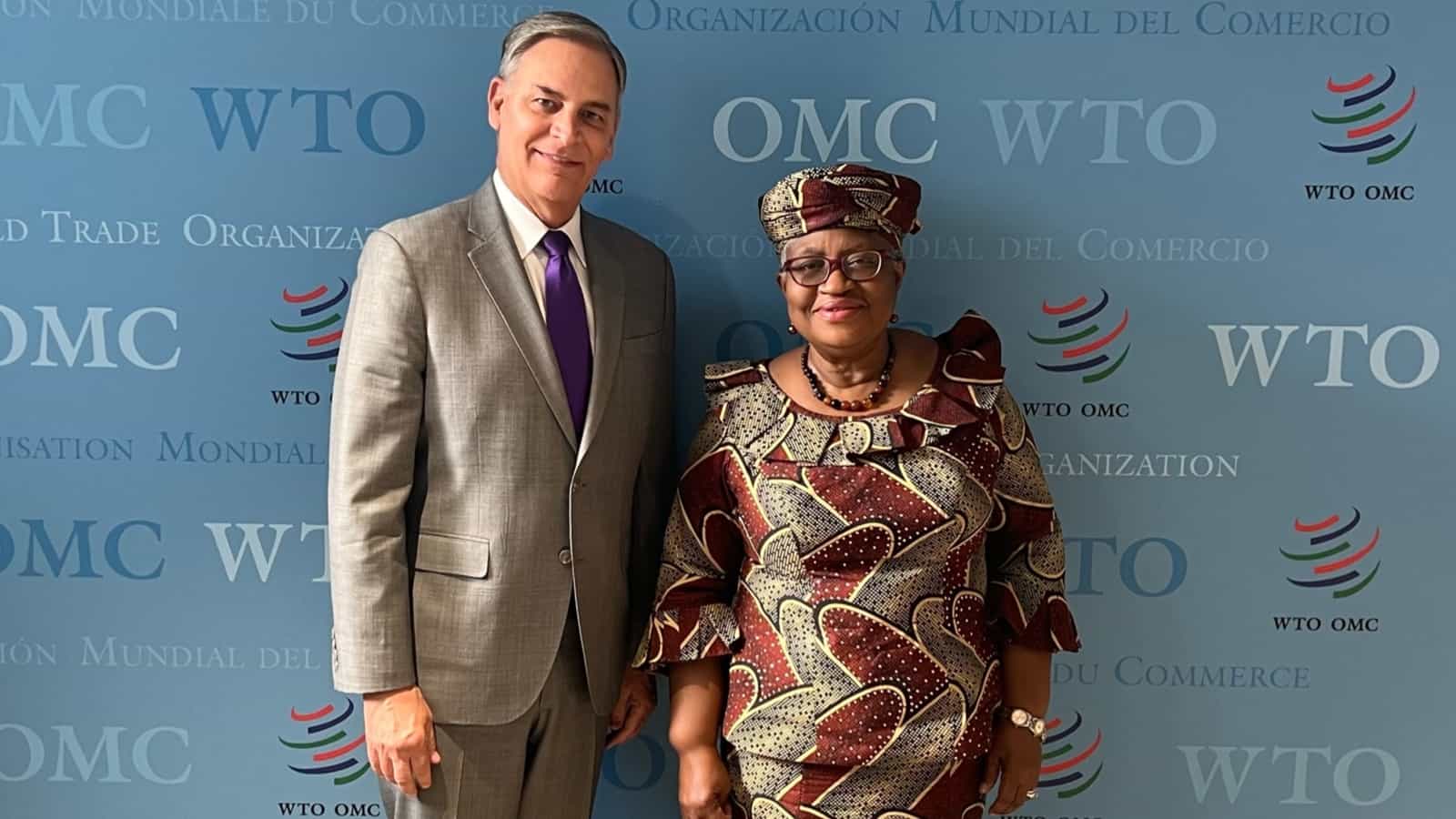
On the first two days of the NAM’s Competing to Win Tour in Europe, Timmons took part in “frank and engaging” discussions with global leaders in Geneva. The conversations focused on reinforcing transatlantic partnerships, bolstering democracy, addressing trade challenges and emphasizing the crucial role manufacturers play in promoting global stability.
The details: Timmons met with influential figures including WTO Director-General Dr. Ngozi Okonjo-Iweala, WTO Deputy Director General Angela Ellard, U.S. Ambassador to Switzerland and Lichtenstein Scott Miller and U.S. Deputy Chief of Mission in Geneva David Bisbee.
- NAM representatives also participated in an event on intellectual property co-hosted by the NAM and the International Federation of Pharmaceutical Manufacturers and Associations.
The substance: In the meetings, Timmons delved into the negative impact of the WTO/TRIPS waiver expansion, the need to restore the WTO dispute settlement system’s functionality and the crucial role of manufacturers in supporting democracies and global institutions.
- ‘“Frank & engaging discussion w/ @JayTimmonsNAM CEO of the US National Association of Manufacturers & his delegation. Focused on geopolitical tensions & impact of @wto, challenges w/ the TRIPS waiver extension to therapeutics & diagnostics, dispute settlement system & road to #MC13 [the WTO’s next ministerial conference in early 2024],” tweeted Okonjo-Iweala following the meeting.
Speech in brief: At the IFPMA event, first covered by Politico, Timmons stressed the significance of IP protections in driving innovation and developing new treatments, reinforcing the NAM’s opposition to an expansion of the TRIPS waiver to cover diagnostics and therapeutics. Attendees included Geneva-based government delegations, the WTO secretariat and NAM member companies.
- “In America, our industry works to advance the values of free enterprise, competitiveness, individual liberty and equal opportunity—the values that keep our industry strong,” said Timmons. “But increasingly, we find these values, which so many of us share, under attack—in particular from authoritarian regimes that have little regard for free markets and little respect for an individual’s right to determine their own destiny. That’s why our transatlantic relationship matters more than at any time in recent memory.”
- “[O]ne of the most important ingredients for innovation is how a country protects intellectual property. IP enshrines the understanding that years or even decades of hard work and sleepless nights, millions and millions of dollars and so much more will be rewarded,” he continued.
- “Expanding this [WTO/TRIPS waiver of IP] would set a precedent that would spiral across the manufacturing sector,” he concluded. “Some voices—here in Geneva and around the world—are already expressing desires to implement similar waivers for renewable and green energy technologies, or to automatically trigger an IP waiver for any future pandemic. If we don’t draw the line now, the outcome is obvious: an anti-innovation domino effect that destroys jobs, livelihoods and lifechanging products.”
The big picture: More than a worldwide center for diplomacy, Switzerland is the seventh largest investor in the U.S. Timmons’s visit comes at a critical inflection point for the country and amid heightened stresses on global institutions, due to COVID-19, Russia’s unprovoked war in Ukraine and competition with China, among other geopolitical challenges.
News coverage: Politico’s Morning Trade newsletter spotlighted Timmons’s trip, while The Wall Street Journal (subscription) quoted him on the importance of new U.S. trade agreements.
Next up: The tour will continue in Frankfurt, Germany, where the NAM will further demonstrate manufacturers’ leadership and the potential for a more robust transatlantic alliance.
Senators Reintroduce Crucial R&D Bill

A bipartisan Senate duo introduced legislation on Thursday that would both allow businesses to once again fully deduct R&D expenses in the year they are made and expand the refundable R&D tax credit.
What’s going on: The American Innovation and Jobs Act, sponsored by Sens. Maggie Hassan (D-NH) and Todd Young (R-IN), would restore the immediate deductibility of R&D expenses. Last year, a tax change went into effect requiring companies to amortize or deduct their R&D investments over a period of years, making R&D more costly.
Why it’s important: According to a recent NAM analysis, the sector would lose nearly 60,000 jobs and face an output decline of more than $31 billion this year alone if the change is not reversed.
- The U.S. has now become a global outlier, joining Belgium as the only other developed country requiring the amortization of R&D expenses.
- Meanwhile, China provides a 200% “super deduction”—20 times the amount allowed in the U.S. tax code—for its manufacturers’ research.
The NAM says: “Manufacturers applaud the introduction of the American Innovation and Jobs Act, which will help the U.S. out-compete China,” said NAM Managing Vice President of Tax and Domestic Economic Policy Chris Netram.
- “Across the country, manufacturers are hiring workers, investing in communities and creating the products, materials and processes that drive us forward. Congress should approve the American Innovation and Jobs Act quickly to support critical research that allows manufacturers to improve lives in America and for people around the world.”
Learn more: Read our stories on how the 2022 expensing requirement is impacting International Paper, Marlin Steel Wire Products, Ultragenyx, Miltec UV and Brewer Science (whose story was also covered today by The Wall Street Journal, subscription).
Sens. Hassan and Young Reintroduce Crucial R&D Legislation
American Innovation and Jobs Act will ensure that the tax code supports the ability of manufacturers to out-compete China and create well-paying jobs
Washington, D.C. – Following the introduction of the American Innovation and Jobs Act by Sens. Maggie Hassan (D-NH) and Todd Young (R-IN), National Association of Manufacturers Managing Vice President of Tax and Domestic Economic Policy Chris Netram released the following statement:
“Manufacturers are hiring workers, investing in communities across the United States and creating the products, materials and processes that drive America forward. Manufacturers applaud the introduction of the bipartisan American Innovation and Jobs Act, which restores full deductions for research, helping the American industry out-compete China, which provides a 200% super deduction for manufacturers’ research—20 times the amount in the U.S. tax code,” said Netram. “Manufacturers, the vast majority of which are quite small, perform 55% of private-sector research and development. These investments in innovation spur economic growth and support the creation of high-paying jobs across the country. Congress should approve the American Innovation and Jobs Act quickly to support critical research that allows manufacturers to improve lives in America and for people around the world.”
Background: As of 2022, manufacturers can no longer immediately deduct their R&D expenses in the year in which they are incurred. Instead, manufacturers must deduct or amortize their expenses over a number of years, which makes R&D much more expensive to undertake. The American Innovation and Jobs Act would restore the immediate deductibility of R&D expenses, a policy that was in place for nearly 70 years. In the 117th Congress, the American Innovation and Jobs Act garnered 35 cosponsors: 17 Democrats and 18 Republicans. A recent analysis released by the NAM finds that the industry would lose 59,392 jobs and face a decline in output of $31.69 billion this year if Congress does not act.
-NAM-
The National Association of Manufacturers is the largest manufacturing association in the United States, representing small and large manufacturers in every industrial sector and in all 50 states. Manufacturing employs nearly 13 million men and women, contributes $2.81 trillion to the U.S. economy annually and accounts for 55% of private-sector research and development. The NAM is the powerful voice of the manufacturing community and the leading advocate for a policy agenda that helps manufacturers compete in the global economy and create jobs across the United States. For more information about the NAM or to follow us on Twitter and Facebook, please visit www.nam.org.
A Young Engineer Makes Herself Heard in Manufacturing
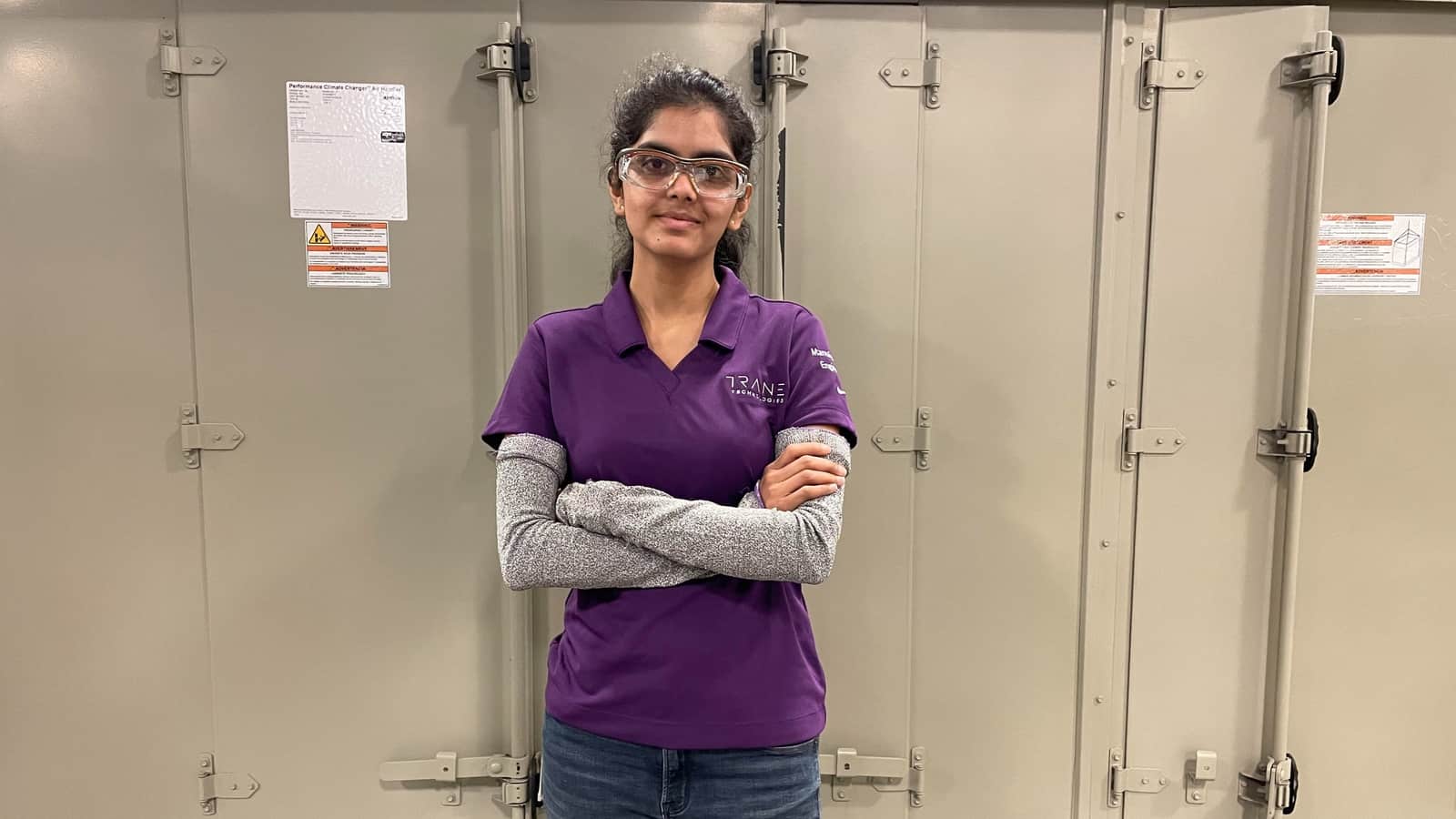
Rashmi Vadlakonda is a woman with a voice, and she’s not afraid to use it.
As a manufacturing engineer at Trane Technologies—a company focused on sustainable climate innovations—Vadlakonda is making advancements in engineering and paving the way for more women of color to join her. That’s why she was recently recognized by the Manufacturing Institute’s 2023 Women MAKE Awards as an Emerging Leader.
The award: The Women MAKE Awards, formerly known as the STEP Ahead Awards, honor top female talent in the industry while providing honorees with a platform to inspire other future industry leaders. Vadlakonda sees the honor as an opportunity to keep speaking up for people who are underrepresented.
- “I believe that for young women in manufacturing, especially for me as an immigrant young woman of color … a title helps,” said Vadlakonda. “This award gives me that title [and] the courage that I need to speak up and say, ‘Hey, I have something to share, and I want you to listen to me. There’s a reason I was recognized.’”
Starting out: Vadlakonda wasn’t immediately drawn to engineering, but when she was growing up in India, it was typical for young people to pursue engineering or medicine.
- Once she “fell into it,” she loved it, and took an especially strong interest in 3D printing while in graduate school at North Carolina State University. Her passion for 3D printing is what brought her to Trane Technologies.
Making the transition: When she first came to the company, she was responsible for operationalizing additive manufacturing throughout the company.
- She spent a few years in a corporate setting, traveling to different offices and introducing advanced manufacturing technologies—but when the pandemic hit and travel was largely suspended, she had plenty of time to think about what she wanted to do next. That’s when she decided to pivot to working in a factory setting.
- “The factory is a basic building block of the manufacturing industry,” said Vadlakonda. “Coming from a research background, I wanted to understand how a factory functions, how the people there think, how different groups interact with each other, and what it takes to actually deliver a good product.”
The factory floor: Vadlakonda is grateful she got a chance to work in both the corporate and factory environments. In a factory, she says, the pace is much faster, and you’re pushed to solve problems right in front of you. This was a challenge she found thrilling.
To women in the industry: When asked what her advice is for women in the industry, Vadlakonda first had advice for industry leaders. She believes they must create a comfortable environment for people from all walks of life.
- “Sure, you can get someone interested in manufacturing, you can help them come into the industry,” said Vadlakonda. “But we also have the responsibility of creating a welcoming environment where they feel like they can grow, so that they don’t leave, so that they’re happy here in the industry.”
The future: Vadlakonda, who is a champion of, and volunteer for, the industry’s Creators Wanted campaign to inspire the next generation of creators, believes it is vital that young people are exposed to manufacturing career options at an early age.
- “It doesn’t start with talking to women who have decided on a career path,” said Vadlakonda. “You have to start with kids. That’s why I like talking at Creators Wanted. Young people are naturally attracted to what they’re attracted to. Our job as adults is to help them see the options.”
The last word: “Manufacturing is very exciting,” said Vadlakonda. “It’s very interesting, you get to be creative and solve problems—and it’s such a satisfying feeling to solve problems.”
AB InBev Uses Smart Manufacturing for Award-Winning Results
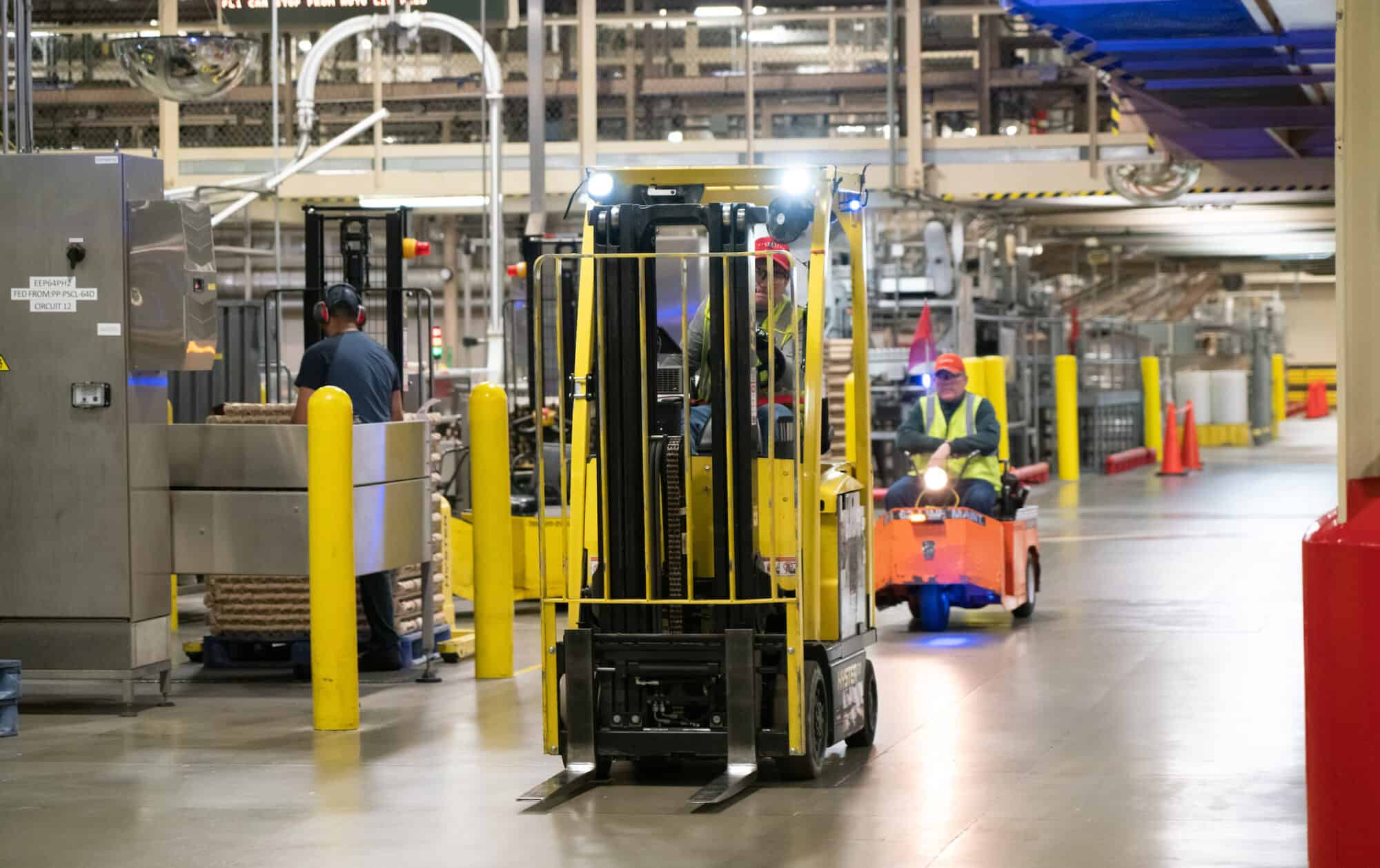
What does it take to be a digital transformation champion? Anheuser-Busch InBev can tell you.
The world’s largest brewer won four Manufacturing Leadership Awards in 2022, including the highly coveted Manufacturer of the Year. (The honors are given annually by the Manufacturing Leadership Council, the NAM’s digital transformation arm.) The MLC chatted with AB InBev Global Vice President Marcelo Ribeiro recently to get his insights on the processes, technologies and strategies driving the company’s success.
Business transformation drivers: “We have a dream at ABI, which is ‘to create a future with more cheers,’” said Ribeiro. “[That means] a clear strategy to lead and grow, to digitize and monetize our ecosystem and to optimize our business.” Here are a few ways AB InBev is pursuing that dream:
- Developing and delivering products that give consumers what they want, when they want it
- Making sure the supply chain can adapt quickly to consumer needs
- Increasing capacity without compromising safety, quality or sustainability
Rising to challenges: “The future is becoming less predictable,” Ribeiro said. “We need to prepare for that, so we have to build a more resilient, flexible supply chain.” Additional opportunities include:
- Moving from transactional relationships with vendors and suppliers to partnerships
- Looking beyond operations and across the entire supply chain to meet sustainability goals
- Creating a collaborative manufacturing ecosystem that fosters the sharing of ideas
Meeting the digital future: Ribeiro says that ABI’s digital strategy has three key aspects:
- Making data more accessible and available to frontline workers
- Creating a template for digital technology that can be easily tailored to the unique needs of each business
- Using advanced analytics to contextualize data and discover where it can best be applied to aid decision making
Leaders required: Ribeiro noted that leadership is essential for making this vision a reality.
- “It is critical to empower the front line,” he said. “Leaders should be focused on providing the resources to allow people to do the work and achieve excellence themselves. In the end, people are key for any business transformation.”
Find additional insights into AB InBev’s digital transformation in DIALOGUE: AB InBev’s Award-Winning Dream, or make plans to attend Rethink, where Ribeiro will present a keynote address on “Building Your Enterprise into a Digital Transformation Champion.”
E-Cycling Helps Manufacturers Generate Business Value

Electronic waste is a big problem.
In 2019, the world generated a record 53.6 million metric tons of discarded electronic and electrical devices, according to a Global E-waste Monitor report. That’s an increase of 21% in just five years. But there’s more: The figure is expected to double by 2050, hitting 120 million tons annually.
The good news is that manufacturers can be an active part of the solution. Though their bread and butter has typically been bringing new products to market, manufacturers are now also developing end-of-life processes for goods to mitigate environmental impact, according to Bright Machines Vice President of Industrial Solutions Adam Montoya, writing in the Manufacturing Leadership Council’s Manufacturing Leadership Journal. (The MLC is the digital transformation division of the NAM).
The challenge: complex components. Disassembling a product is not nearly as straightforward as assembling it, according to Montoya. Take a server, for example. A company might know what’s inside it based on its original configuration, but memory or processor upgrades could have changed over the course of its life.
- When a lot of change has taken place, the dismantling process is unique to each server, making it complex and difficult to automate.
The solution: intelligent disassembly. Improving the end-of-life process for electronics requires intelligent disassembly, a combination of smart technology and a different way of thinking, says Montoya. Here’s how it works:
- Automation technology that uses AI and advanced vision systems interprets the contents of a particular component and compares it against the original blueprint.
- Next, the system assesses the presence and location of components within the unit.
- It then sorts, separates and removes components so they can be reclaimed or recycled.
The bottom line: Manufacturers stand to realize many benefits from intelligent disassembly. Components with sensitive data can have machine-driven proof of destruction. Systems with usable parts can be repurposed rapidly.
- Ultimately, it’s an important way for manufacturers to collectively reduce carbon footprints and electronic waste while delivering business value, says Montoya.
For more on this topic, read Rethinking End-of-Life Technology Value in the Manufacturing Leadership Journal. And to learn more about how manufacturing leaders are undertaking digital transformations, join the MLC at its Rethink conference in Marco Island, Florida, on June 26–28.
How a Tax Change Could Set Back Cancer Treatment
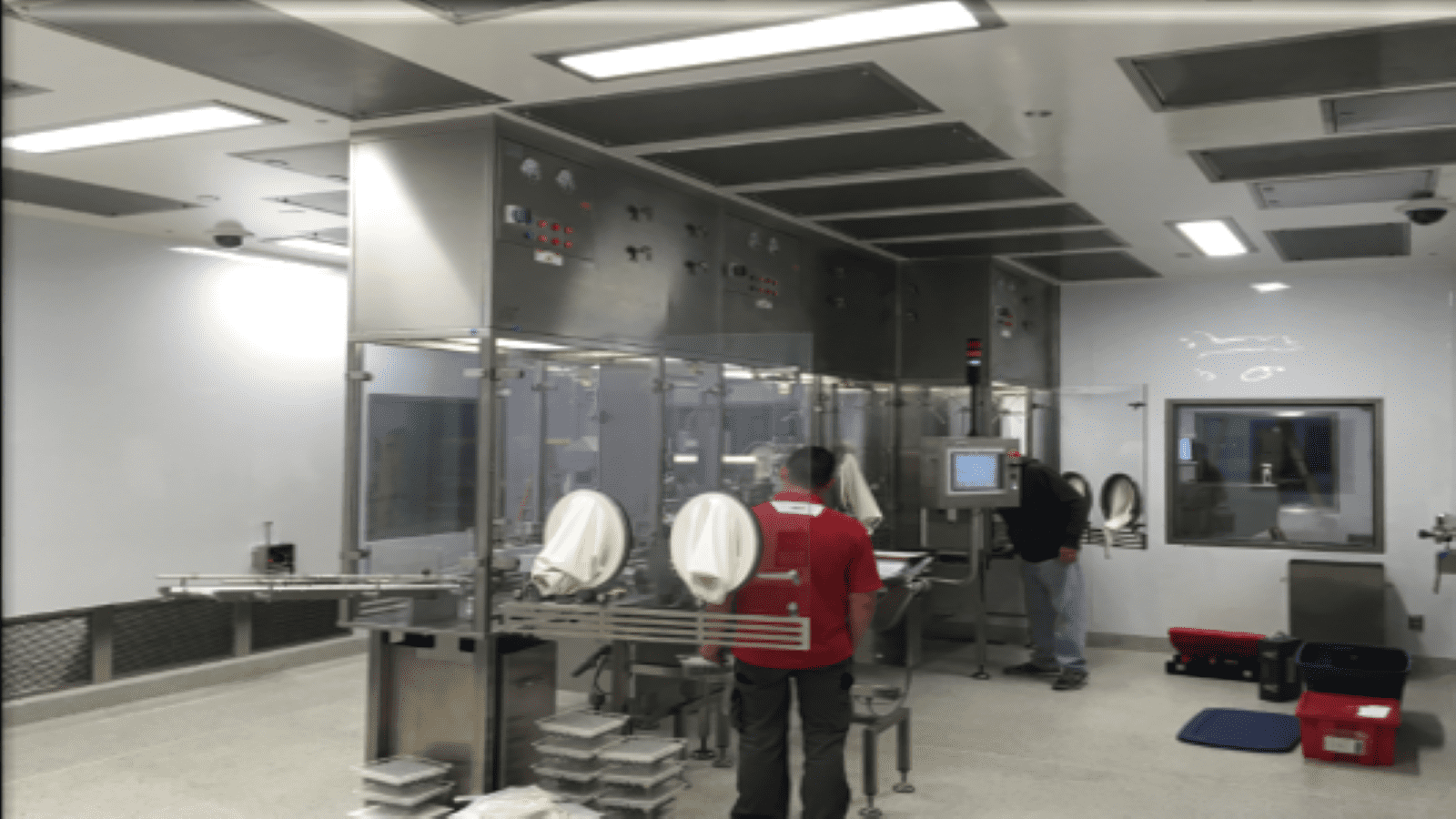
An idea becomes a prototype, then a treatment, then a lifesaver. That’s how R&D is supposed to work, but as Tolmar, Inc., can tell you, tax policy is a crucial element as well.
Tolmar spent years developing a therapy to improve the treatment of advanced prostate cancer. The resulting long-acting injectable, called ELIGARD®, works by stopping testosterone production to slow the growth of cancer cells. It’s a remarkable technology, now used by patients nationwide and around the world who are fighting advanced prostate cancer.
This innovation was facilitated by a U.S. tax policy that supported R&D investments by pharmaceutical companies. However, a recent change means that Tolmar and other pharmaceutical R&D units will find it more difficult to produce innovations that make human lives better, safer, healthier and longer.
The problem: Until about a year ago, businesses were able to deduct 100% of their R&D expenses in the year in which they incurred the expenses. Starting in 2022, however, a change in tax policy requires businesses to spread their R&D deductions out over a period of five years, making it more expensive to invest in innovation.
The cost for companies: “We have a finite amount of capital to put into the development of new products. The changes in tax policy will lead to difficult decisions,” said, Tolmar Chief Financial Officer Jeff Lederman.
- “We typically put the vast majority of our cash back into the company—whether that means investing in R&D, capital purchases or our workforce—and if we have less funding, we have to cut back in some or all of those areas. So, this policy change could have a significant impact on our organization.”
The cost to patients: This tax change could also have a negative impact on patients in the United States and around the world by delaying the development and availability of innovative new therapeutic products.
- Tolmar is one of a small number of U.S. manufacturers of long-acting injectable prostate cancer treatments, and the company has a number of other innovative medicines and therapeutics in its pipeline.
- “This is not so much about saving dollars; it’s about patient impact,” said Tolmar President and Chief Operating Officer Shawn Silvestri. “The results we’re chasing are meaningful to patients’ lives. If you’re looking for something that’s purpose-driven, that’s the kind of work we do—and that makes the choices for me that much more difficult.”
A competitive disadvantage: While the impact on patients is the most worrisome effect, the R&D tax change also has negative implications for American economic competitiveness.
- Making research more expensive puts companies that operate in the U.S., as Tolmar does, at a distinct disadvantage, especially when other countries are aggressively supporting domestic research.
Our move: At the NAM, we’re pushing Congress to reverse this change and allow manufacturers to keep investing in innovation, jobs and workers. Learn more and take action at www.nam.org/protect-innovation.
Manufacturers Lend a Hand in Turkey, Syria
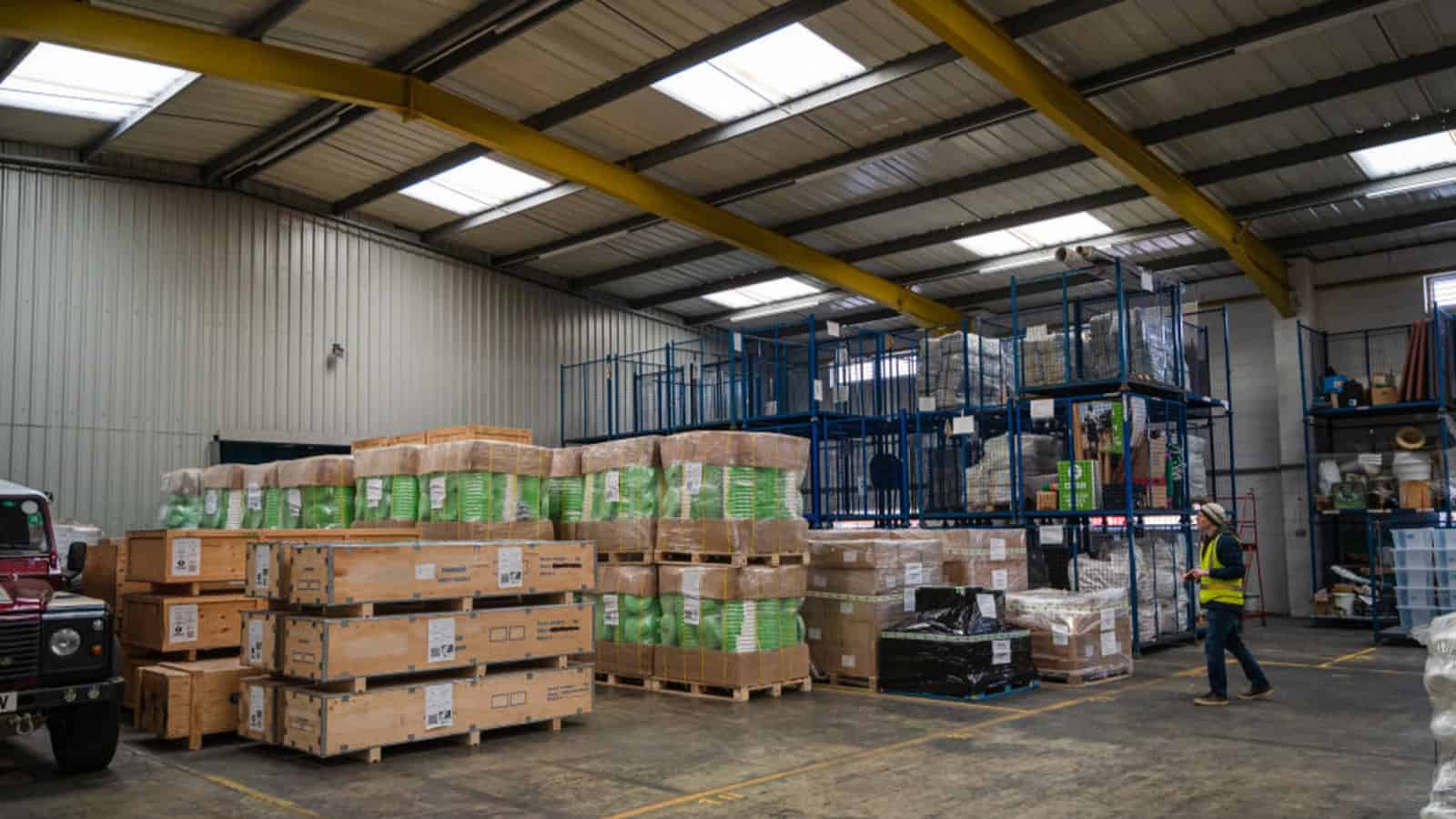
It’s been nearly a month since a devastating earthquake hit Turkey and Syria, killing at least 50,000 people—but manufacturers haven’t stopped lending a hand.
What’s going on: Through NAM Emergency Response Committee partners Project HOPE and Good 360, as well as other avenues, manufacturers in the U.S. were among the first to offer supplies and services to survivors. Here is just a sampling of the aid they provided.
Transport help: Manufacturers in the logistics sector stepped up to help ship necessary goods and supplies.
- The UPS Foundation has committed $1 million in global logistics support and employee-contributions matches.
- FedEx has committed more than $1 million of in-kind shipping so far.
Funds: Others are giving sizable monetary donations to the relief efforts.
- The Caterpillar Foundation is donating $400,000 to support relief efforts.
- Boeing Charitable Trust is giving a $500,000 donation.
- Novartis is donating $1 million.
- Rockwell Automation is donating $50,000 to the American Red Cross.
- Siemens has donated more than $1 million.
Supplies: Many manufacturers have also been donating much-needed goods to the earthquake victims.
- In addition to donating $1.2 million, the PepsiCo Foundation has partnered with nonprofits Tider and Ahbap to deliver essentials, including food, water, sanitation and hygiene products, along with container shelters, blankets and other emergency supplies.
- The Kraft Heinz Foundation is sending food and care products and donating $500,000 to the Red Cross.
- The Abbott Fund has committed $1.5 million in grants and product donations.
How to help: If you’d like to help those in need in Turkey and Syria, the NAM Emergency Response Committee offers options:
- To donate needed products—including hygiene kits, cold-weather clothing or health supplies—please visit Good360’s goods-donation page.
- If you want to give funds to support humanitarian relief, you can do so via the NAM’s partnership with Project HOPE.
Share your story: The NAM Emergency Response Committee is looking to hear from manufacturers about how they may have been affected by the earthquake and how they may be helping. To share your stories, please contact the NAM Emergency Response Committee at [email protected].
Modine Keeps the Digital Economy Cool and Functional
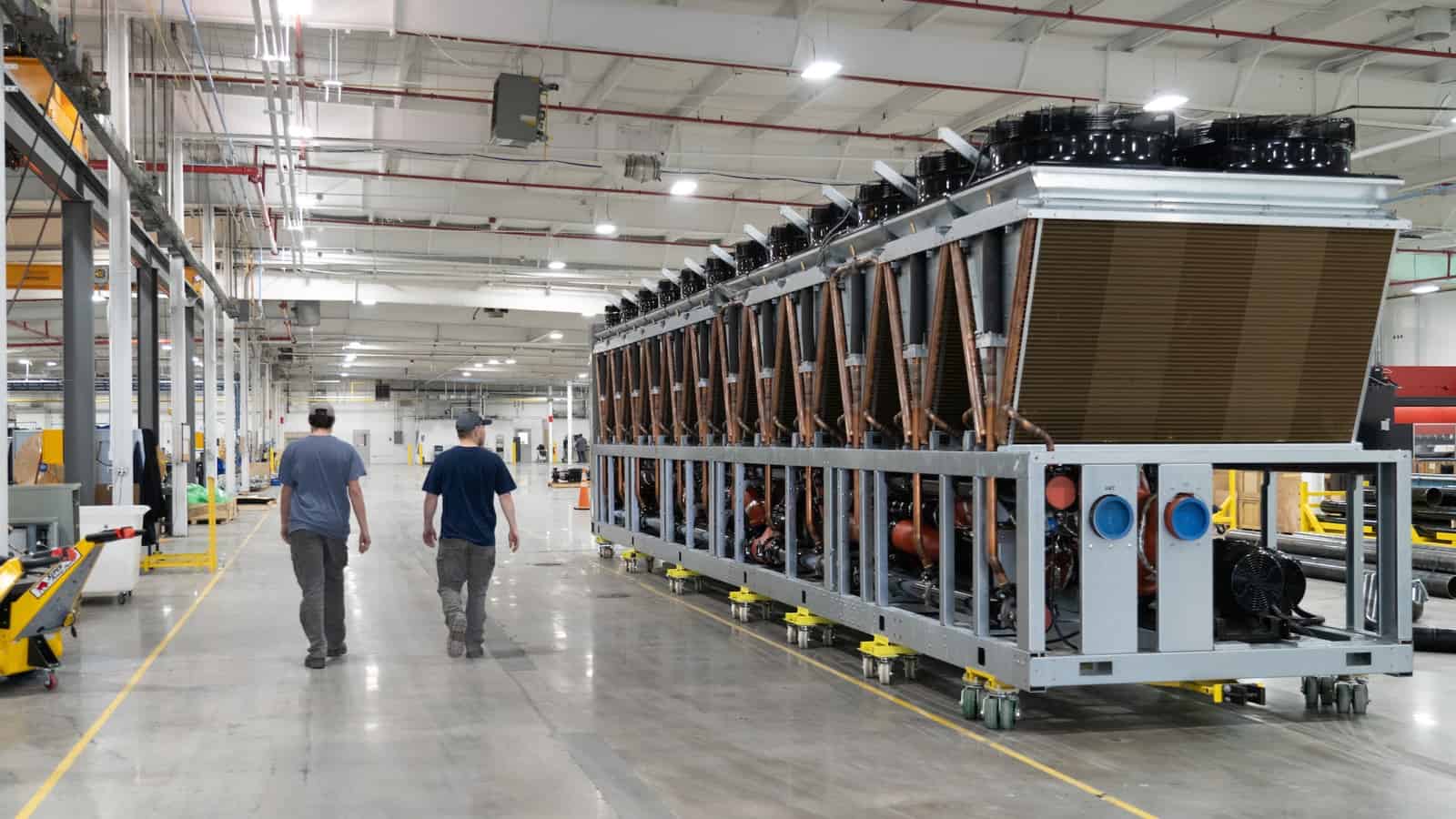
Here’s the secret ingredient in the digital economy: data center chillers. All those enormous data centers that keep track of your bank account, work emails and lunch orders get very hot, requiring state-of-the-art cooling technology to keep them functional and efficient.
We recently got to see how these enormous machines are made, courtesy of Modine Manufacturing, which opened its first data center chiller production plant in Rockbridge, Virginia, back in November. NAM Senior Director of Photography David Bohrer captured the production line in action, while several of Modine’s leaders spoke to the NAM at a later date about the technology involved.
Why chillers? The demand for data center chillers rises with the demand for data, which seems to be pretty much endless nowadays.
- As Darren Farrar, Modine’s global head of marketing for data centers, explained, “Data centers are always on; they are constantly processing data and therefore producing heat. They use a lot of energy, so any incremental improvements we can make [in cooling technology] can make a lot of difference to energy bills.”
- That’s where Modine comes in. Though chillers have been around since the 1920s, the needs of the digital economy mean that further innovation and specialization are always necessary.
How it works: A chiller provides cool water to the data center building while removing the heat that is returned from it, in an endless cycle.
- Modine’s chillers have two circuits, one of which uses outdoor air to chill the water, in a process called “free cooling,” explained Rob Bedard, general manager of data centers, North America. It’s a method that provides considerable energy savings.
- The chiller also has a “classical” refrigeration circuit for when outdoor temperatures aren’t helpful. Last, fans on top of the unit vent heat away from the building.
How it’s made: The Rockbridge plant is Modine’s first data center chiller plant in the U.S. and is situated in Virginia due to the state’s high concentration of data centers, said Bedard. The facility is “purpose-designed” for production, and everything is done on site:
- Technicians cut the parts from raw materials, then add refrigeration, suction and the distinctive V-shaped pipes for coolant, explained Tommy Johnson, Rockbridge’s plant manager.
- The assembly line checks the pressure, ensures there are no leaks and does final testing, he added. The facility even hosts demonstrations for customers in a state-of-the-art test lab, so they know what they’re getting.
Here a team constructs the metal frame of the chiller and adds insulation to the copper pipework and heat exchangers that carry the refrigerant:

Another technician installs the massive fans on top of the structure, which draw air through the huge V-shaped heat exchangers, removing the heat and venting it upward:
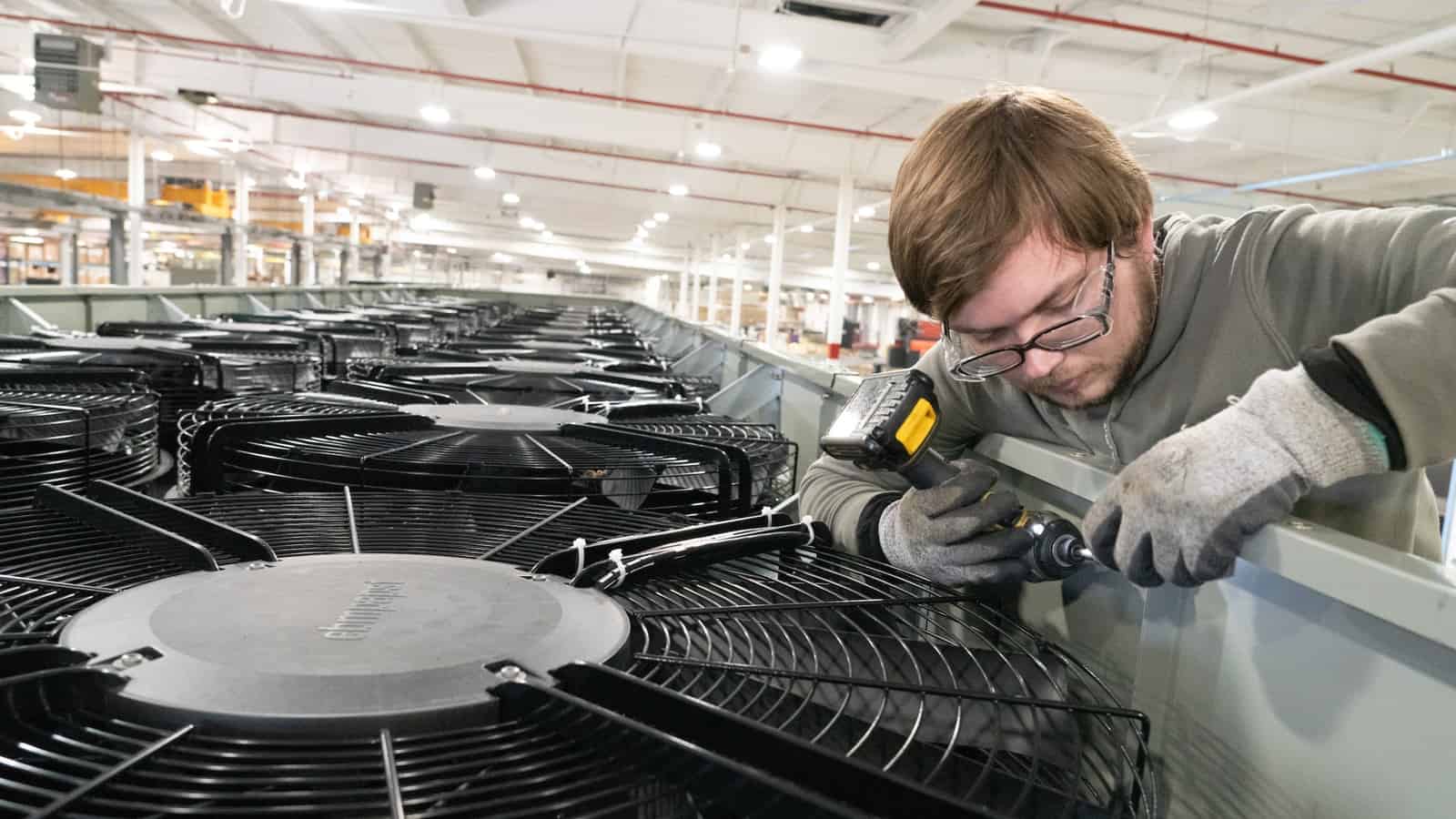
These copper pipes circulate water through the unit:
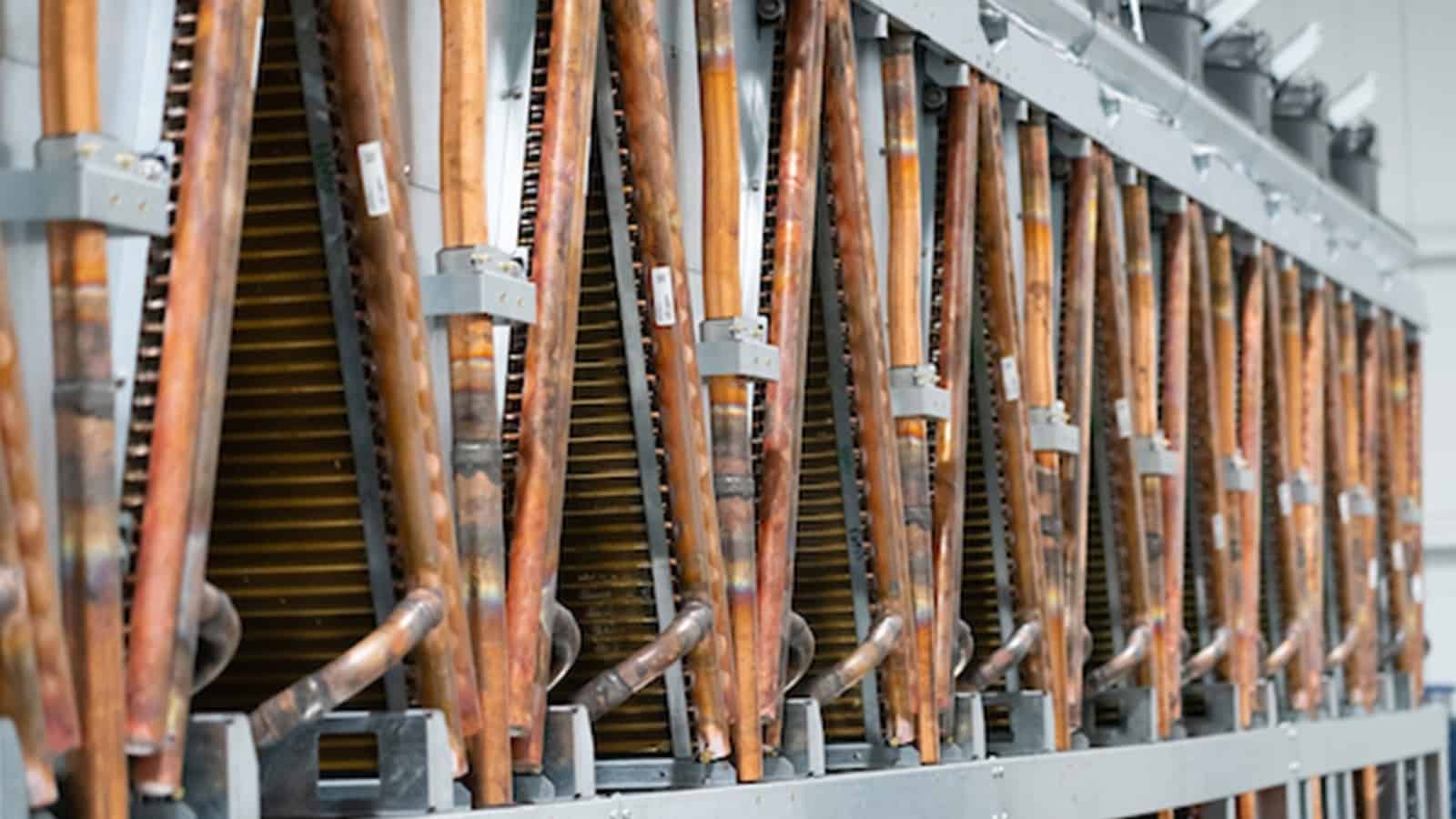
And last, here is the nearly finished chiller, which stands an impressive 10.1 feet tall, 45.6 feet long and 7.8 feet wide:
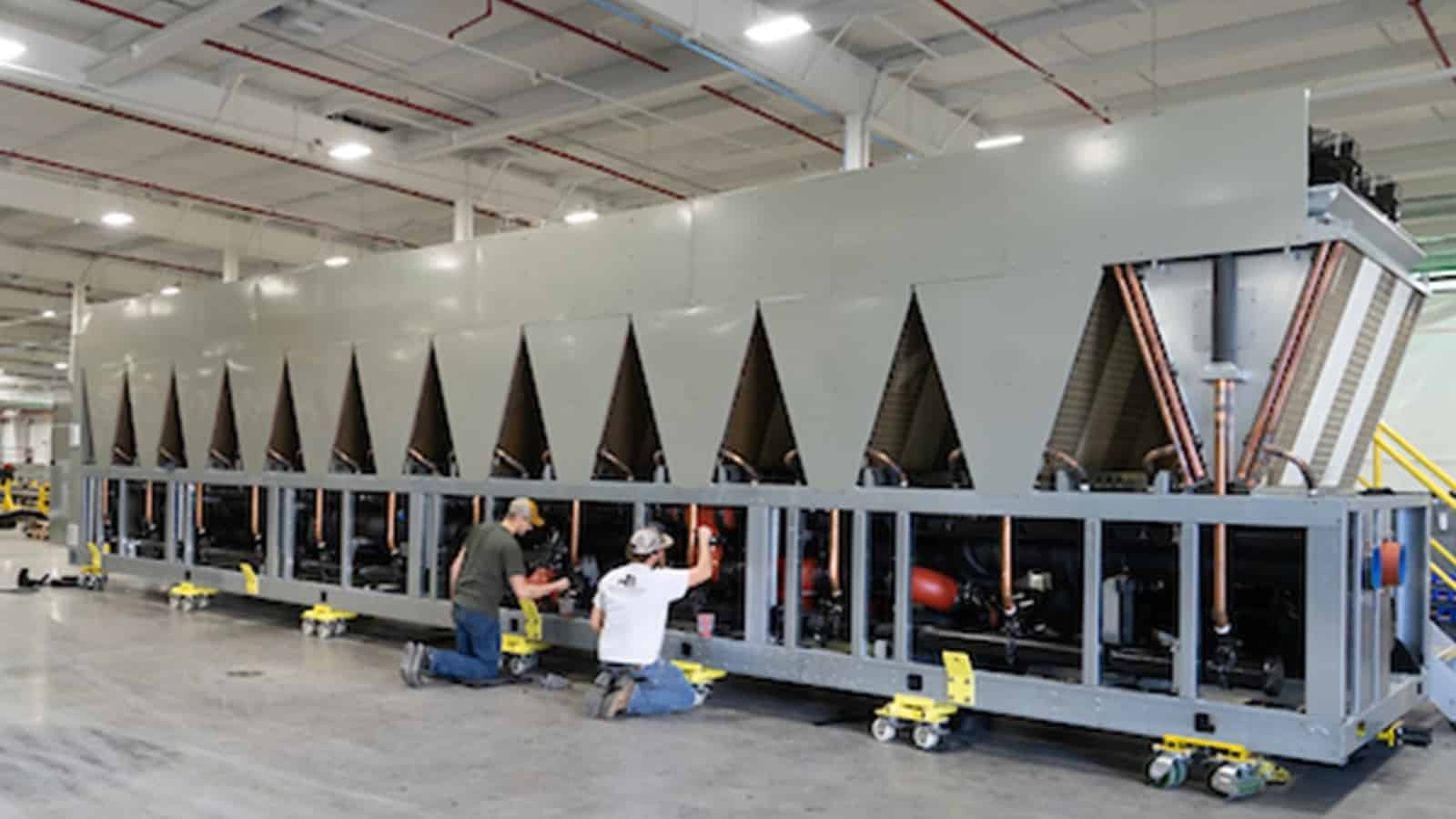
What’s next: What does Modine predict for the future of this market?
- “As big IT companies develop high-density chips,” Farrar said, “existing data centers will only become more powerful—and thus hotter.” Meanwhile, the increasing use of AI and cryptocurrency will also lead to greater demand for data centers.
- In addition, sustainability will only become more of a priority. As Farrar put it, the data chiller industry will have to learn to grow sustainably throughout its supply chain—by using fewer and greener refrigerants, reducing water and carbon usage and more.
- Modine plans to meet these challenges with its newly commissioned testing center at the Rockbridge facility, where it will do all its own testing and validation for the North American market, Farrar said.
Off to a great start: Today, Modine is confident and optimistic, having recently delivered Rockbridge’s first batch of chillers to a Corescale data center in Gainesville Crossing, Virginia. It was “the culmination of all our efforts for a 2-year period,” said Farrar—a real “red letter day.”
NAM Opposes FTC Ban on Noncompete Agreements
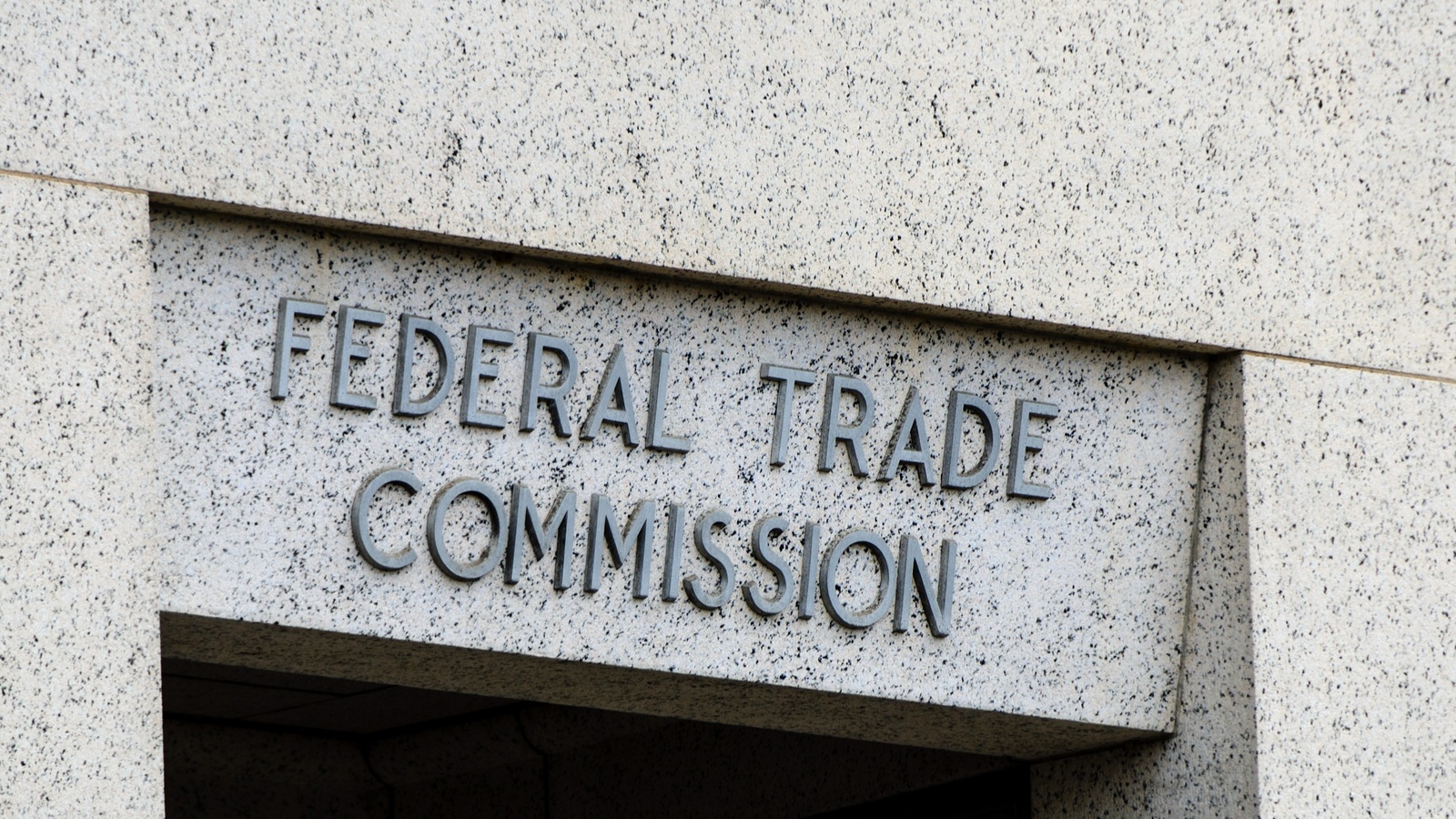
The NAM is opposing the Federal Trade Commission’s proposed ban on all noncompete agreements, pushing back on a move that would damage the manufacturing industry. We talked to NAM Vice President of Infrastructure, Innovation and Human Resources Policy Robyn Boerstling about the NAM’s reasoning on this crucial issue.
What noncompetes do: As Boerstling put it, manufacturers use noncompete agreements only for select workers handling their most sensitive information.
- That information might include the details of the company’s most sophisticated processes and strategies, which cannot be allowed to fall into competitors’ hands.
- Not only do these employees handle the keys to a company’s success, Boerstling added, but they are the recipients of significant investments in time, compensation and training.
The potential damage: Banning noncompetes would force companies to revamp their human capital operations completely, argued Boerstling.
- It would mean that trade secrets or other essential information might walk out the door and be exploited not only by competitors, but also by foreign adversaries.
- Manufacturers would be forced to put in place burdensome controls or silo parts of their operations from each other, which would result in less training for employees and less efficiency across various divisions.
- In a highly competitive industry—not to mention during significant economic uncertainty—that is a high price to pay, Boerstling pointed out.
Why not something else? Noncompete agreements are a critical tool for protecting manufacturers’ intellectual property, and alternatives like nondisclosure agreements are not sufficient, said Boerstling.
- In fact, in IP cases, courts look specifically at whether a company has employed noncompete agreements in deciding whether that company has taken reasonable steps to protect their property and processes.
FTC in the wrong: The FTC is wrong to put forth this blanket ban on a number of counts, said Boerstling.
- First, the rulemaking concerns an issue of “vast economic and political significance” that is beyond the scope of the FTC Act.
- Second, the regulation of these agreements has been handled successfully at the state level, a situation that works well for manufacturers.
- Third, the FTC is being too simplistic by striking at all noncompetes at once. Complex technical industries require noncompetes for good reason, as their sophisticated IP is the core of their business.
- Last, this ban is set to be retroactive, which is sure to cause confusion for both employers and employees.
What the NAM wants: The NAM objects to the FTC’s proposal in its current form and asks that it be withdrawn until the FTC can propose a more tailored approach that allows for sensible exemptions, said Boerstling.